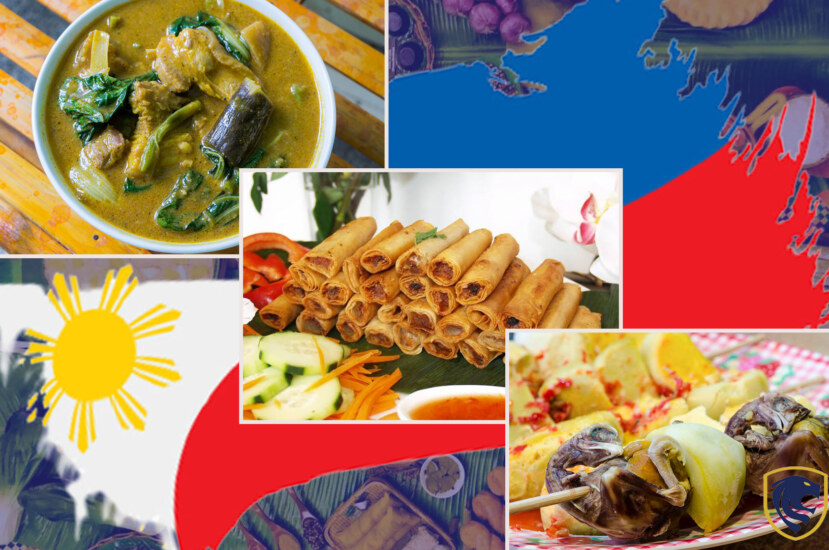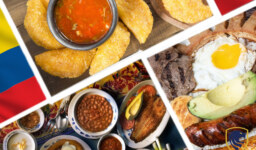Dive into the aromatic world of Filipino cuisine, a treasure trove of diverse flavors and cultural influences. From the bustling streets of Manila to the serene beaches of Palawan, the Philippines boasts a rich culinary heritage shaped by its history and geography. In this article, we will embark on a culinary adventure, exploring the best traditional foods that define the heart and soul of Filipino gastronomy. From savory adobo to the mouthwatering halo-halo, discover the unique and delectable dishes that make Filipino food a global sensation. So, join us as we unravel the secrets behind the country’s most beloved recipes and the stories they tell about Filipino culture and tradition.
Adobo
Adobo, the heart of Filipino cuisine, is a culinary masterpiece adored across the archipelago. It’s also a harmonious blend of simplicity and depth, featuring marinated meat (commonly chicken or pork). The mead is simmered in a heavenly concoction of vinegar, soy sauce, garlic, and spices. The magic of Adobo lies in its transformative power. The meat, tender and flavorful, absorbs the rich marinade during a slow-cooking process. Each region in the Philippines boasts its unique twist, but the essence remains constant: a perfect balance of salty, savory, and slightly tangy flavors.

Adobo; Best Traditional Food In the Philippines
Adobo’s history traces back to pre-colonial times, making it a dish deeply rooted in Filipino heritage. Furthermore, families pass down their secret Adobo recipes through generations, turning them into a symbol of home and tradition. It’s a comforting dish enjoyed in everyday meals and festive celebrations alike.
The versatility of Adobo is astounding. It can be made with chicken, pork, beef, or even seafood, making it adaptable to various tastes. Moreover, it is often served with steamed rice. Adobo showcases the Filipinos’ ingenuity in transforming basic ingredients into a culinary masterpiece. Also, its rich aroma and tantalizing taste make it a quintessential Filipino experience, representing the country’s diverse flavors and the warmth of Filipino hospitality. Adobo isn’t just a dish; it’s a cultural treasure, embodying the essence of Filipino culinary artistry.
Sinigang
A Filipino culinary treasure known as sinigang is a sour and savory soup. It captures the comforting spirit of Filipino home-cooked food. Its characteristic flavor is derived from tamarind, which gives the soup a pleasant tanginess. In addition, Sinigang is a combination of soft meat, different vegetables including water spinach and radish, and occasionally, green chili for an added kick. It is frequently cooked with pig, beef, prawns, or fish.

Sinigang; Best Traditional Food In the Philippines
The excellent harmony between sourness and saltiness and the soothing warmth of Sinigang are what makes it so alluring. A pleasing symphony of flavors is produced by the natural sweetness of vegetables and the sour flavor. A significant quality of sinigang is its adaptability to different ingredients, which enables cooks to customize it to their preferences.
Sinigang is cherished by Filipinos as a hearty meal served at festivals and family get-togethers. Its ancestral ties to traditional Filipino sour soups highlight the nation’s inventiveness in using regional components. Moreover, Sinigang is frequently served sizzling hot with a side of steamed rice, conjuring up images of home-cooked deliciousness and familial devotion. Sinigang embodies the friendly Filipino friendliness for both residents and tourists. Its robust ingredients and sour embrace make it a must-try and offer a gastronomic journey into the core of Filipino culture, where each mouthful narrates a narrative of tradition, flavor, and community.
Lechon
The highlight of Filipino festivities, lechon, is a gastronomic masterpiece that personifies joy and pleasure. This famous meal uses a whole pig that has been painstakingly marinated in herbs and spices before being slowly roasted over an open flame. So, the ultimate result is a vision of golden, crispy skin encasing juicy, soft flesh. More than just a food item, lechon is a cultural icon that is frequently offered only during important celebrations like weddings, birthdays, and fiestas. Lechon preparation is a labor of love that calls for skill and endurance. The perfume filling the air and the sound of the skin crisping all heighten the suspense.

Lechon; Best Traditional Food In the Philippines
Friends and family assemble around the table to serve Lechon, excitedly anticipating their time to enjoy the treasured pork. The skin, or chicharrón, is a highly sought-after delicacy that is cherished for its crisp consistency and robust flavor. Moreover, Lechon provides a well-balanced combination of textures and flavors when served with liver sauce and steamed rice. Beyond its culinary allure, Lechon has great cultural importance, standing in the Philippines for wealth and charity. It delights taste buds and brings together communities for a shared meal, serving as a monument to the nation’s culinary expertise and hospitality. Lechon is the epitome of Filipino festivities, where the happiness of the moment is tasted in each crispy bite.
Halo-Halo
The quintessential Filipino dessert, Halo-Halo, which translates to “mix-mix,” is a colorful combination of tastes and textures. It’s a delicious mixture of shaved ice covered with a variety of sweet toppings, served cold. Each layer offers a different texture and flavor, from vibrant jellies and beans to jackfruit, banana, and yam. So, it is a visual treat to see a scoop of creamy leche flan and purple yam (ube) ice cream perched atop this chilly pile. Also, the last spray of evaporated milk gives the whole thing a rich, decadent richness. Halo-Halo is a sensory experience rather than merely a sweet treat. A pleasing balance is produced by the contrast between the velvety, sweet components and the cold, brittle ice. Each mouthful is a surprise because of the variety of flavors and textures in each bite.

Halo-Halo; Best Traditional Food In the Philippines
Beyond its flavor, Halo-Halo symbolizes the cultural richness of the Philippines. Its components are a reflection of the nation’s history of commerce and colonization, creating a distinctive flavor combination. Halo-Halo is a popular summertime dessert that brings sweet respite and is loved by both families and groups of friends. Halo-Halo is an adventure to eat, and the act of combining the layers turns it into a unique treat. It’s more than simply a dessert. It’s a monument to Filipino inventiveness and the nation’s love of sweets, making it a dish that anybody interested in Filipino cuisine must taste.
Kare-Kare
Kare-Kare is a delicious stew with a deep, nutty flavor. It is indeed a Filipino culinary treasure. It features tripes, oxtail, or both, both of which have been cooked in a rich peanut sauce to make the meat wonderfully soft. The meal is bursting with flavor and is accompanied by a variety of vegetables, including string beans, eggplant, and banana hearts. Kare-Kare is well known for the annatto seeds that give it its distinctive orange color. As a salty counterpoint to the dish’s creamy richness, bagoong, a fermented prawn paste, is typically served with it. Moreover, the flavors blend wonderfully when combined, and bagoong is frequently served on the side.

Kare-Kare; Best Traditional Food In the Philippines
Beyond just being delicious, Kare-kare represents Filipino family customs and is frequently served at events and gatherings. Its origins may be found in the pre-colonial Philippines, and it has since developed into a well-known classic. The thorough preparation of the dish reflects the preference of Filipinos for filling, tasty meals.
The appeal of Kare-Kare is in its capacity to unite people. Families and friends assemble around a hot pot to enjoy this culinary wonder while exchanging tales and amusing anecdotes. Kare-Kare is a staple of Filipino cuisine, showcasing the nation’s culinary creativity and fondness for substantial, filling meals with its diverse flavors and cultural importance.




